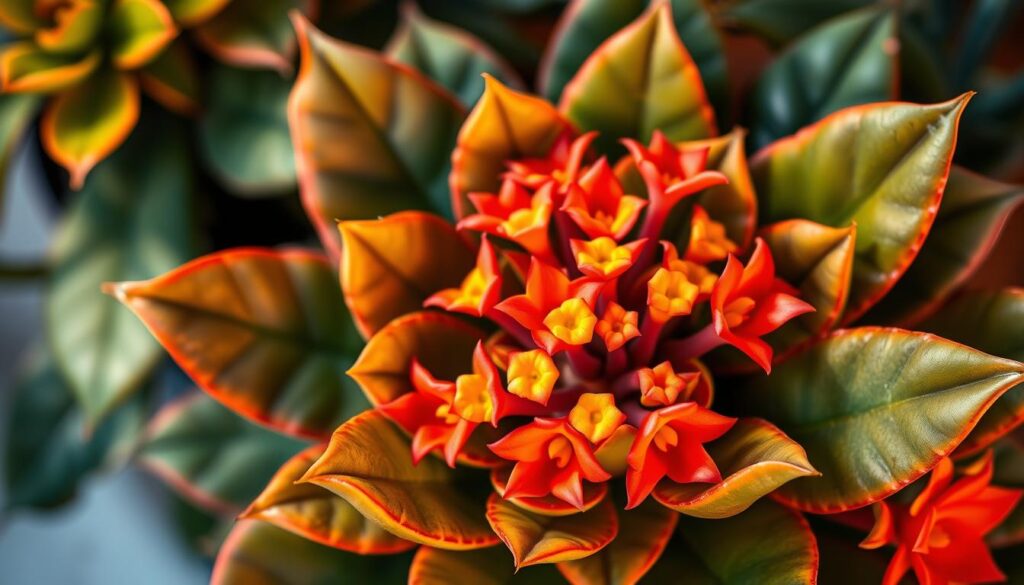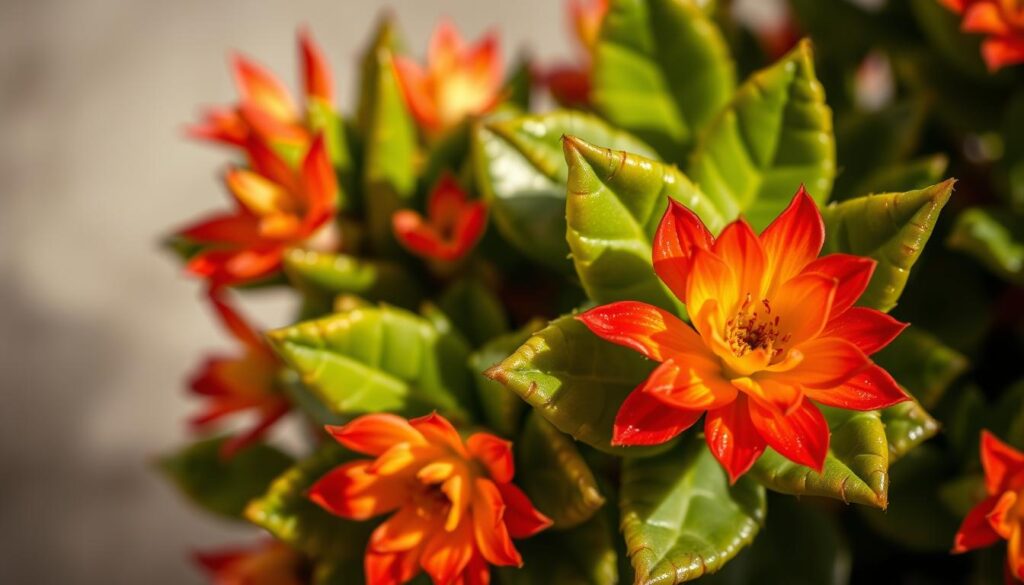There are moments when a simple bloom lifts a gray afternoon. I remember the first time a small kalanchoe brightened my windowsill and felt an honest lift to the room. That memory is why I want this brief guide to feel practical and kind.
The flaming katy is a compact, winter-blooming succulent from Madagascar that forms tight mounds of foliage topped by star-shaped flowers. Most plants stay about 6–12 inches tall and wide, making them perfect for a sunny spot at home.
At a glance: bright, indirect light, let the top 1–2 inches of soil dry between waterings, and use a gritty cactus mix for steady growth. Nighttime coolness and a period of long darkness in late season can trigger reliable reblooming.
Want more detail on seasonal rhythm and set-up? See a practical care overview at growing flaming katy.
Key Takeaways
- Bright, indirect light and well-draining soil are essential.
- Water only after the top 1–2 inches dry to avoid root problems.
- Most stay 6–12 inches—ideal for tabletops and windowsills.
- Provide cooler nights and a winter dark period to set buds.
- Light feeding during active growth helps repeat blooms over years.
Flaming Katy at a Glance: Identify, Origins, and Growth Habits
Meet a compact houseplant that blooms when nights grow long and cool. The flaming katy (Kalanchoe blossfeldiana) is native to Madagascar and was first noted by Robert Blossfeld in 1926. It belongs to the stonecrop family Crassulaceae and shows many forms, from minis to double-petaled varieties.
This petite succulent reaches roughly 6–12 inches tall and wide. Look for glossy, scalloped leaves and dense clusters of star-shaped flowers that typically open in late winter into spring.
Quick ID and Habitat Traits
As a short-day plant, the flaming katy sets buds when daylight hours shorten. Indoors it prefers bright, indirect sunlight and daytime temperatures near 60–75°F, with cooler nights to encourage blooms.
Practical Facts
- Typical size: about 6–12 inches—ideal on sills, desks, or shelves.
- Hardiness: best as a house plant in most U.S. areas; outdoors only in frost-free zones (USDA 10–11).
- Soil: use fast-draining, gritty soil and keep in a well-draining pot.
- Longevity: with the right routine, these plants can bloom for years.
- Cultivars: from ‘Tom Thumb’ minis to larger ‘Goldrand’ and double ‘Calandiva’.
“Fewer daylight hours trigger a reliable flowering cycle in short-day succulents.”
These traits make flaming katy an easy, colorful choice for small spaces and seasonal displays.
Care For Flaming Katy
Small adjustments to light and water make a big difference in how well the plant blooms. Position your specimen where it receives bright, indirect light; east or west windows work best. Too much direct sunlight can scorch leaves, while dim spots reduce flowering.
Water smart: let the top 1–2 inches of soil dry before you water. When you do, water thoroughly and empty any saucer after about 15 minutes so roots never sit in pooled water. Overwatering leads to soft, translucent tissue and possible root rot.
Use a gritty cactus soil or a blend of perlite, coarse sand, and potting soil. Make sure the pot has a drainage hole and add a coarse layer at the bottom to prevent compaction. Refresh soil every couple of years to keep roots healthy.
Aim for daytime temperatures around 60–75°F and cooler nights near 50–60°F. Keep humidity low and skip misting; dry air suits this succulent and reduces fungal risk. Feed lightly with a balanced fertilizer every 4–6 weeks during active growth and pause in winter.
“Protect the plant from harsh midday rays; a sheer curtain often softens direct sunlight while preserving brightness.”
Seasonal Care and Re-Blooming Indoors
To coax repeat blooms, schedule a brief period of intentionally long nights and cooler days.
Winter dormancy: To trigger buds, give the plant 14–16 hours darkness daily for about 6–8 weeks. Keep temperatures near 59–64°F (15–18°C), cut back watering, and stop feeding so energy goes to bud set.

Summer placement
In warm months move the pot to a bright, rain-sheltered area outdoors. Avoid driving rain and harsh midday sunlight. Bring the kalanchoe back indoors before nights drop near 50°F so the plant stays safe.
Post-bloom routine
After flowers fade, deadhead spent clusters and do light pruning to shape the plant. This tidies the silhouette and encourages branching for the next season.
“If you skip the dark period, expect fewer or no flowers the next season.”
- Aim for consistent darkness each night—use a closet or cover the pot to avoid interruptions.
- Once buds appear, return to bright, indirect light, resume moderate water, and feed lightly to support a full flaming katy bloom.
Troubleshooting Problems: Leaves, Pests, and Diseases
Yellow leaves, sticky residue, or fine webbing are clues that this plant needs attention.

Diagnose water stress first. Soggy soil and translucent, drooping leaves point to overwatering. Bone-dry soil and limp foliage mean it’s time to water.
Overwatering and root rot fixes
If rot sets in, unpot the kalanchoe and trim brown, mushy roots. Let cuts callus, then repot into fresh, gritty soil that drains fast.
Reduce frequency of watering and empty any saucer after 15 minutes to avoid pooled water.
Pests and treatment
Aphids, mealybugs, and spider mites hide under leaves and at stem joints. Wipe foliage first, then treat with neem oil or insecticidal soap.
- Spray weekly until pests clear.
- Isolate the affected plant and target the undersides of leaves to break life cycles.
Leaf issues and other diseases
Scorched patches mean too much direct sunlight; move the pot back a few feet or use a sheer curtain.
White, powdery coatings wipe off—prune infected parts and improve air flow. Refresh compacted soil that stays wet; better drainage often restores vigor.
“Monitor new growth: firm, colorful leaves show the plant is recovering.”
Propagation and Repotting for Long-Term Growth
Rooting new plants from cuttings is simple and rewarding with a little patience. Use clean tools and a steady routine to keep new specimens healthy.
Stem cuttings and offsets
Take 2–4 inch stem cuttings with a sterile knife. Remove the lower leaves and let the cut end callus for a day.
Plant tips into a fast-draining cactus or potting soil mix. Water lightly and keep the medium barely moist until roots form.
Basal offsets can be separated with a clean knife, allowed to callus, then potted individually to clone the parent color and form.
Leaf cuttings and rooting tips
Try leaf cuttings by lightly scoring veins and laying leaves on moist mix. Create a humidity tent and vent it daily to prevent mold.
Keep trays warm (about 68–72°F) and bright but out of direct sun; gentle warmth speeds growth without stressing tissue.
When and how to repot
These compact plants rarely need larger pots. Refresh with fresh soil every 2–3 years to renew nutrients and structure.
Use a gritty, airy mix and avoid unnecessary upsizing; young roots prefer high porosity and steady drainage.
“Clean cuts, a short callus period, and gritty media make propagation reliable and repeatable.”
Safe Placement, Pets, and Home Environment
Choose a spot that protects blossoms from ethylene sources and curious paws. Place plant containers in well-ventilated areas of the home to avoid gases that trigger bud drop.
Ethylene sensitivity
Keep the flaming katy away from ripening fruit, cigarette smoke, and car exhaust. These sources emit ethylene and can cause premature flower loss. Make sure the display area is not near kitchens, garages, or smoker’s rooms.
Toxicity and pet safety
This kalanchoe is toxic to cats. Treat this katy succulent as off-limits to pets and children.
Position pots on high shelves or inside closed rooms. If ingestion occurs, contact a veterinarian right away.
“Good placement protects blooms and keeps family members and pets safe.”
- Choose a placement that avoids ethylene sources and heavy foot traffic.
- Keep sunlight morning or late-afternoon only; avoid harsh midday rays.
- Keep humidity low and skip misting to prevent fungal issues.
- Bring containers back indoors before nights become chilly.
| Risk | Typical source | Action |
|---|---|---|
| Ethylene exposure | Fruit bowls, smoke, exhaust | Move plant to ventilated room; avoid kitchens/garages |
| Pet ingestion | Cats and curious pets | Place high or in closed rooms; seek vet if eaten |
| Fungal issues | High humidity, misting | Keep area dry; provide airflow and bright light |
| Cold stress | Outdoor nights below 50°F | Bring back indoors well before chilly nights |
Conclusion
, A simple routine rewards every owner.
Keep bright, indirect light, a fast-draining cactus soil or potting soil mix, and water by touch rather than a strict schedule. Use a pot with a drainage hole and empty saucers so roots stay healthy.
To set a reliable flaming katy bloom, give 14–16 hours of darkness for 6–8 weeks in winter, lower temperatures slightly, and cut back on water and fertilizer during that time.
Propagate with stem cuttings using a clean knife and refresh fresh soil every couple years. Treat pests with neem oil when needed. With steady, seasonal care this compact plant will reward you with color year after year.

